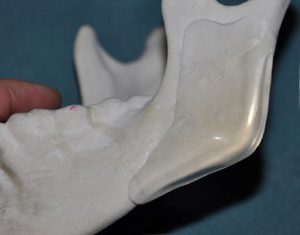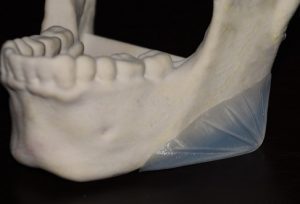Jaw angle implants have become a more common procedure for men in the effort to achieve a stronger and more defined mandibular shape. By highlighting the jaw angles in combination with a more prominent chin, a triangular lower facial shape is seen from the frontal view. By increasing the divergence of two lines that follow the jawline from the chin back, jaw shape becomes increasingly more masculinized. There is a point at which this divergence is too great and the jaw shape can look more cartoonish than natural, but this only happens when the jaw angle sticks out further than one’s ears.
This frontal view of the jaw angle oversimplifies, however, the three dimensional shape of this facial area. Because the jaw angle is formed by both horizontal and vertical ramus bone segments, it’s vertical height has a significant impact on how increasing the lateral expansion of the angle will look. A high mandibular angle shortens the face and increases the downward plane of the jaw. A lower mandibular angle lengthens the face and levels out the jaw plane angle. Which one of these jaw angle heights may offer an aesthetic benefit for anyone is based on the other dimensions and shape of their face.


Lowering the jaw angle also causes it to acquire a more 90 degree or square shape versus a more open angle (greater than 90 degrees) when it is higher. This is a profile jaw aesthetic that can be gender-specific. A lower jaw angle means more masseter muscle and a flatter jaw line from front to back, a more masculine facial feature. A high jaw angle reduces the amount of bone for masseter attachment and placed the jaw angle point above the horizontal plane of the chin. This can be more feminine in appearance.
Jaw angle augmentation is more than just about widening the jaw. It requires three-dimensional planning and proper implant selection to get the desired result.
Dr. Barry Eppley
Indianapolis, Indiana


